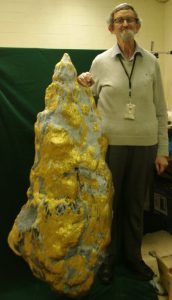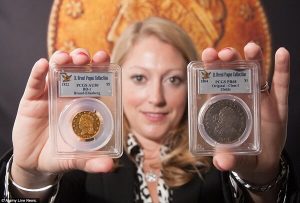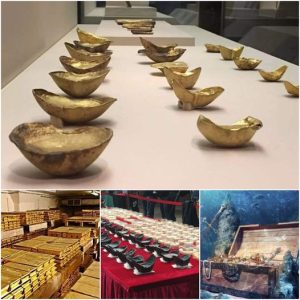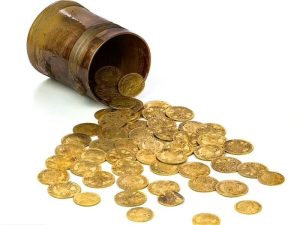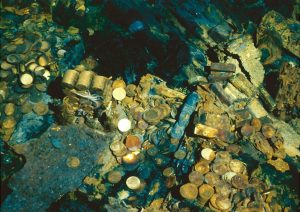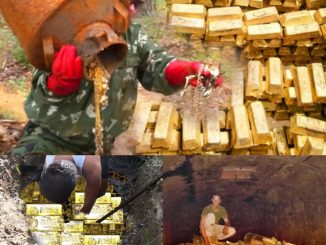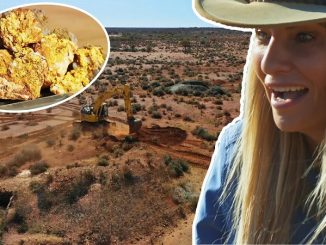An undersea treasure hunter believes a cache of pirate treasure – lost 300 years ago in a ship wreck – is burned at the end of a ‘yellow brick road’ off Cape Cod in Massachusetts.
The infamous Whydah Gally went down in a storm in 1717 – taking with it a massive booty, including a of 400,000 gold and silver coins. The wreck was found in 1984, but not all its treasure.
Explorer Barry Clifford believes he has found a trail of gold coins that will lead him to the priceless plunder.
‘We think we’re very, very close,’ he said.
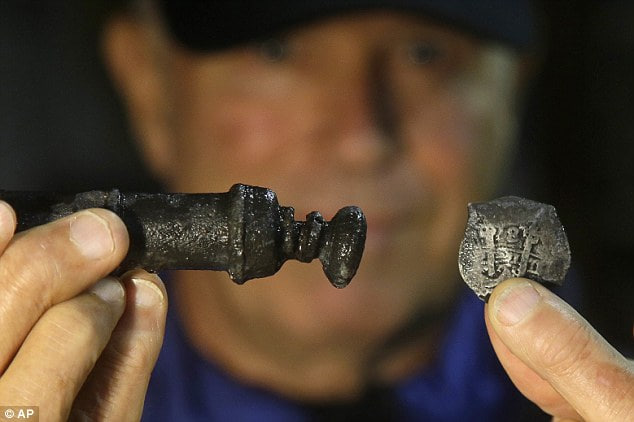
Yellow brick road: Treasure hunter Barry Clifford holds up a metal syringe and a Spanish coin that he salvaged on the ‘yellow brick road’ that he believes leads the way to a trove of 400,000 priceless coins

Mysterious: The pirate ship Whydah Gally, modeled here, went down in a squally off Cape Cod nearly 300 years ago
He believes that as the Whydah Gally – a British slave ship that was captured by the infamous ‘Black Sam’ Bellamy – broke apart the trove of coins and other treasure poured from the stern as the ship broke up and the stern drifted away after the ship went down in a gale force storm on April 26, 1717.
Bellamy and his crew of 143 pirates went down with the ship. Only two survivors lived to tell the tale.
At the time, it was carrying plunder from its raids on 50 ships. Clifford discovered the wreck site in 1984 off Wellfleet and has since pulled up 200,000 artifacts, including gold ornaments, sword handles, even a boy’s leg.
But just this year, Clifford learned far more treasure may be resting with the Whydah, the only authenticated pirate shipwreck in U.S. waters.
Colonial-era documents discovered in April indicated the Whydah raided two vessels in the weeks before it sank. Its haul on those raids included 400,000 coins, the records said.
A September 1 dive during what was supposed to be Clifford’s last trip of the season uncovered evidence he was near those coins. That convinced Clifford he had to make another trip before summer’s end. So Clifford and a seven-man crew went back on a three-day trip that ended September 13.
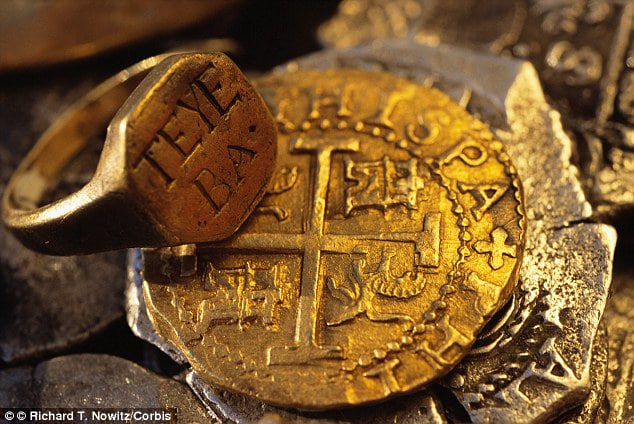
Clifford has brought a significant amounts of treasure up from the wreckage of the Whydah in the nearly 30 years since its discovery. However, he believes the biggest cache could still be beneath the sea
Clifford headed for the ‘yellow brick road,’ which refers to a gold and artifact-strewn path extending between two significant sites at the Whydah wreck that are about 700 feet apart – a cannon pile and a large chunk of wood that Clifford thinks is the Whydah’s stern.
Divers searching the path on the recent trip pulled up several concretions, which are rocky masses that form when metals, such as gold and silver, chemically react to seawater. Diver Jon Matel said one discovery was following another, even though divers were working in ‘black water,’ or zero-visibility.
Matel says several feet of a fine seaweed called mung settled in the excavated pits and it was like diving in a vat of black gelatin dessert.
‘You’re going by your feel, your touch, your hands, and the ping of a metal detector,’ Matel said. ‘When that thing goes off, it’s a great feeling.’
X-rays show all the newly retrieved concretions have coins and gold inside. To Clifford it’s more proof of high concentrations of metals and coins being dumped en masse on that spot of sea floor.
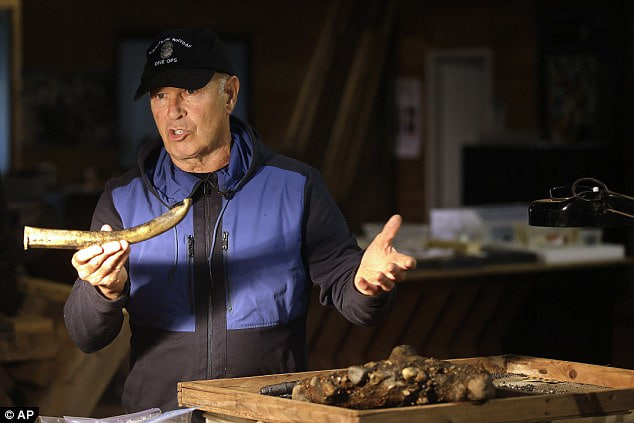
Clifford hold the deformed, partially-crushed barrel of a blunderbus he salvaged from the 1717 wreck
Clifford believes two examples that were pulled up on the previous trip are particularly compelling evidence: a cannonball piled with 11 coins and a foot-and-a-half long piece of iron stacked with 50 coins.
‘Did all of those coins just happen to fall on this one little piece of iron? Or were there thousands of coins there, and this is just an example of what’s left?’ he said.
Clifford has no doubt it’s the latter, but he’ll have to wait until next summer to try to find out.
He’s taken 21 trips this summer at a cost of more than $200,000. But the worsening weather and lingering boat problems after a recent lightning strike make another visit impossible until June.
Clifford doesn’t sell Whydah artifacts, though he knows the treasure, both uncovered and hidden, has monetary and historic value. He anticipates the delay until the next trip will be somewhat maddening.
‘I’ll wake up in the middle of the night this winter and go, “Oh my God, I know what that means,” when I’m reviewing something from the Whydah,’ he said. ‘And then I can hardly wait to get back there in the spring.’
souce: https://www.dailymail.co.uk/
